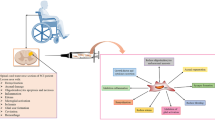Abstract
Objective
To investigate the effect of H2O2 on the migration and antioxidant defense of mesenchymal stem cells (MSCs) and the neurotrophic effects of H2O2-treated MSCs on spinal cord injury (SCI).
Results
Sublethal concentrations of H2O2 decreased cell migration and expression of CXCR4 and CCR2 as well as Nrf2 expression in MSCs. In the second phase, transplantation of treated and untreated MSCs to SCI caused minor changes in locomotor dysfunction. There was a significantly difference between cell-treated and spinal cord injury groups in expression of BDNF (brain-derived neurotrophic factor). Transplantation of H2O2-treated cells caused an increase in BDNF expression compared to non-treated cells.
Conclusion
Transplantation of H2O2-treated stem cells may have protective effects against SCI through by increasing neurotrophic factors.







Similar content being viewed by others
References
Basso DM, Beattie MS, Bresnahan JC (1995) A sensitive and reliable locomotor rating scale for open field testing in rats. J Neurotrauma 12:1–21
Chang C-P, Chio C-C, Cheong C-U, Chao C-M, Cheng B-C, Lin M-T (2013) Hypoxic preconditioning enhances the therapeutic potential of the secretome from cultured human mesenchymal stem cells in experimental traumatic brain injury. Clin Sci 124:165–176
Der Sarkissian S, Lévesque T, Noiseux N (2017) Optimizing stem cells for cardiac repair: current status and new frontiers in regenerative cardiology. World J Stem Cells 9:9
Devine SM, Cobbs C, Jennings M, Bartholomew A, Hoffman R (2003) Mesenchymal stem cells distribute to a wide range of tissues following systemic infusion into nonhuman primates. Blood 101:2999–3001
Himes BT et al (2006) Recovery of function following grafting of human bone marrow-derived stromal cells into the injured spinal cord. Neurorehab Neural Repair 20:278–296
Imura T, Tomiyasu M, Otsuru N, Nakagawa K, Otsuka T (2017) Hypoxic preconditioning increases the neuroprotective effects of mesenchymal stem cells in a rat model of spinal cord injury. J Stem Cell Res Ther 7:2
Jang Y-Y, Sharkis SJ (2007) A low level of reactive oxygen species selects for primitive hematopoietic stem cells that may reside in the low-oxygenic niche. Blood 110:3056–3063
Le Belle JE et al (2011) Proliferative neural stem cells have high endogenous ROS levels that regulate self-renewal and neurogenesis in a PI3K/Akt-dependent manner. Cell Stem Cell 8:59–71
Lin T-M, Tsai J-L, Lin S-D, Lai C-S, Chang C-C (2005) Accelerated growth and prolonged lifespan of adipose tissue-derived human mesenchymal stem cells in a medium using reduced calcium and antioxidants. Stem Cells Dev 14:92–102
Nardi NB, da Silva LM (2008) Mesenchymal stem cells: isolation, in vitro expansion and characterization. Stem cells. Springer, Berlin, pp 249–282
Nishimoto T, Matsumoto A, Kihara T, Akaike A, Sugimoto H (2009) Protective effect of H2O2 against subsequent H2O2-induced cytotoxicity involves activation of the PI3K-Akt signaling pathway. Cell Mol Biol 56:OL1447
Pourjafar M, Saidijam M, Mansouri K, Malih S, Nejad RT, Shabab N, Najafi R (2016) Cytoprotective effects of endothelin-1 on mesenchymal stem cells: an in vitro study. Clin Exp Pharmacol Physiol l43:769–776
Zhang J et al (2012) Hydrogen peroxide preconditioning enhances the therapeutic efficacy of Wharton’s Jelly mesenchymal stem cells after myocardial infarction. Chin Med J 125:3472–3478
Acknowledgement
This study was funded and approved by the Ethics Committee of Hamadan University of Medical Sciences (No. IR.UMSHA.REC.1394.67). The Funding Number is 9403262453.
Supplementary information
Supplementary Table 1—Sequences of primers for qRT-PCR.
Author information
Authors and Affiliations
Corresponding author
Ethics declarations
Conflict of interest
The authors declare no conflict of interest.
Electronic supplementary material
Below is the link to the electronic supplementary material.
Rights and permissions
About this article
Cite this article
Rahimi, A., Amiri, I., Roushandeh, A.M. et al. Sublethal concentration of H2O2 enhances the protective effect of mesenchymal stem cells in rat model of spinal cord injury. Biotechnol Lett 40, 609–615 (2018). https://doi.org/10.1007/s10529-017-2499-7
Received:
Accepted:
Published:
Issue Date:
DOI: https://doi.org/10.1007/s10529-017-2499-7




